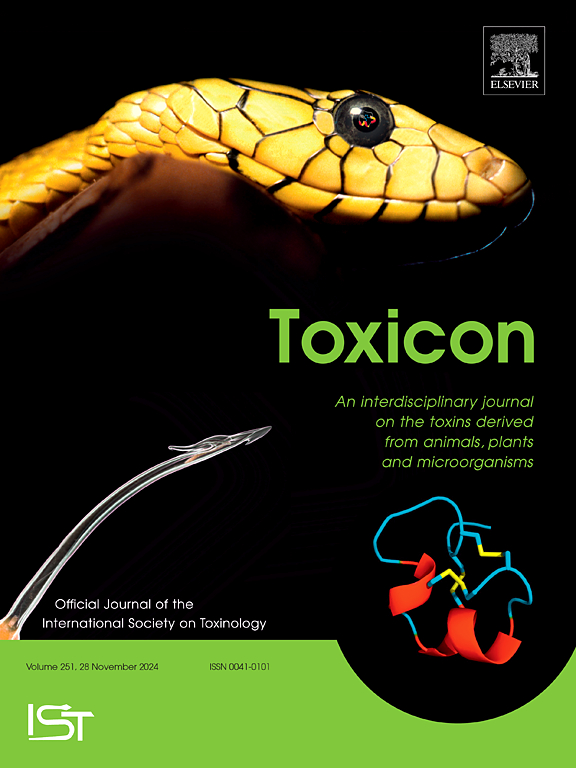了解红肉虫和白肉虫毒液对人凝血的影响。
IF 2.6
4区 医学
Q2 PHARMACOLOGY & PHARMACY
引用次数: 0
摘要
凝血功能障碍是由属Bothrops蛇引起的中毒的主要症状。在巴西东北部地区,红斑Bothrops (Bothrops erythromelas)和白斑Bothrops leucurus是造成蛇咬伤事故的主要原因。考虑到它们的毒液不用于抗蛇毒血清的生产,本研究的目的是表征红黑螺旋体和白螺旋体毒液的凝血毒性特征,以及它们的中和潜力。对于这些物种毒液靶向的凝血成分,白鲟样品具有更高的凝血酶样活性和激活凝血酶原的能力,而因子X的激活在两种物种之间具有可比性。红黑螺旋体和白螺旋体毒液具有α-和β-纤维蛋白原分解活性,其中红黑螺旋体毒液具有较高的整体纤维蛋白原分解活性。相比之下,红melas B.毒液对人血浆表现出更强的促凝活性,通过毒液样品诱导的凝血时间和血栓弹性测量来评估。双体抗蛇毒血清对白鲟毒液的促凝潜能的抑制作用优于红褐螺旋藻。然而,抗蛇毒血清中和这种活性的能力比用于生产抗蛇毒血清的白蚁的毒液要低。本文的研究结果描述了白螺旋藻和红螺旋藻毒液的促凝活性,并强调了它们对人类血浆促凝能力的差异,有助于更深入地了解这些物种引起的毒液中毒的病理生理。本文章由计算机程序翻译,如有差异,请以英文原文为准。

Understanding the effects of Bothrops erythromelas and Bothrops leucurus venoms on human blood coagulation
Coagulation disorders are a primary symptom of envenomation caused by snakes belonging to the genus Bothrops. In the Northeast region of Brazil, the species Bothrops erythromelas and Bothrops leucurus are the main responsible for snakebite accidents. Due to the specific action of Bothrops venoms on several components of the coagulation cascade, the objective of this work was to characterize the coagulotoxic profile of B. erythromelas and B. leucurus venoms and the neutralizing potential of bothropic antivenom, considering that their venom are not used in the production of antivenom. Regarding the clotting components targeted by the venom of these species, B. leucurus samples had higher thrombin-like activity and ability to activate prothrombin, while the activation of Factor X was comparable between these two species. B.erythromelas and B. leucurus venom displayed α- and β-fibrinogenolytic activities, with the former presenting higher overall fibrinogenolytic activity. In contrast, B. erythromelas venom showed greater procoagulant activity on human plasma, assessed through the coagulation time induced by the venom samples and thromboelastometry. Bothropic antivenom inhibited the procoagulant potential of B. leucurus venom better than B. erythromelas. However, the ability of the antivenom to neutralize this activity is lower compared to that determined for the venom of B. jararaca, which is used for antivenom production. The results shown herein describe the procoagulant activity of B. leucurus and B. erythromelas venoms and highlight the differences regarding their procoagulant capacity on human plasma, contributing to a deeper understanding of the pathophysiology of the envenomation caused by these species.
求助全文
通过发布文献求助,成功后即可免费获取论文全文。
去求助
来源期刊

Toxicon
医学-毒理学
CiteScore
4.80
自引率
10.70%
发文量
358
审稿时长
68 days
期刊介绍:
Toxicon has an open access mirror Toxicon: X, sharing the same aims and scope, editorial team, submission system and rigorous peer review. An introductory offer Toxicon: X - full waiver of the Open Access fee.
Toxicon''s "aims and scope" are to publish:
-articles containing the results of original research on problems related to toxins derived from animals, plants and microorganisms
-papers on novel findings related to the chemical, pharmacological, toxicological, and immunological properties of natural toxins
-molecular biological studies of toxins and other genes from poisonous and venomous organisms that advance understanding of the role or function of toxins
-clinical observations on poisoning and envenoming where a new therapeutic principle has been proposed or a decidedly superior clinical result has been obtained.
-material on the use of toxins as tools in studying biological processes and material on subjects related to venom and antivenom problems.
-articles on the translational application of toxins, for example as drugs and insecticides
-epidemiological studies on envenoming or poisoning, so long as they highlight a previously unrecognised medical problem or provide insight into the prevention or medical treatment of envenoming or poisoning. Retrospective surveys of hospital records, especially those lacking species identification, will not be considered for publication. Properly designed prospective community-based surveys are strongly encouraged.
-articles describing well-known activities of venoms, such as antibacterial, anticancer, and analgesic activities of arachnid venoms, without any attempt to define the mechanism of action or purify the active component, will not be considered for publication in Toxicon.
-review articles on problems related to toxinology.
To encourage the exchange of ideas, sections of the journal may be devoted to Short Communications, Letters to the Editor and activities of the affiliated societies.
 求助内容:
求助内容: 应助结果提醒方式:
应助结果提醒方式:


